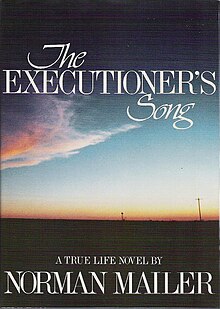The Executioner's Song

First edition cover
|
|
| Author | Norman Mailer |
|---|---|
| Country | United States |
| Language | English |
| Publisher | Little, Brown |
|
Publication date
|
1979 |
| Media type | Print (hardback & paperback) |
The Executioner's Song (1979) is a Pulitzer Prize-winning novel by Norman Mailer that depicts the events related to the execution of Gary Gilmore for murder by the state of Utah. It was a finalist for the 1980 National Book Award. The title of the book may be a play on "The Lord High Executioner's Song" from Gilbert and Sullivan's The Mikado. "The Executioner's Song" is also the title of a poem by Mailer, published in Fuck You magazine in September 1964 and reprinted in Cannibals and Christians (1966).
Notable for its portrayal of Gilmore and the anguish generated by the murders he committed, the book was central to the national debate over the revival of capital punishment by the Supreme Court. Gilmore was the first person to be executed in the United States since the re-instatement of the death penalty in 1976.
In April 1976, Gilmore, age 35, was released from prison after serving 13 years for armed robbery in Indiana. He was flown to Utah to live with his cousin Brenda Nicol, who agreed to be his sponsor and tried to help him find work. Gilmore soon met and became romantically involved with Nicole Baker, a 19-year-old widow with two young children who was separated from her second husband. Despite his efforts to reform himself, Gilmore had a pattern of emotional volatility and self-destructive behavior, resulting in fighting, stealing, and using drugs. After Nicole broke up with Gilmore in July, he murdered two men in two separate robberies on succeeding days. Gilmore was turned in by Brenda Nicol.
He was convicted of murder at trial in September and sentenced to death. The execution was stayed on three occasions. Gilmore became a national media sensation after he fought to have his execution performed as soon as possible. He and Nicole agreed to a suicide pact that resulted in each of them suffering temporary comas in November. On January 17, 1977, after appeals filed by lawyers on behalf of the American Civil Liberties Union (in defiance of Gilmore's wishes) were rejected by the US Supreme Court, Gilmore was executed by the method he chose: firing squad. He was the first person to be judicially executed in the United States since Luis Monge was executed in the Colorado gas chamber on June 2, 1967.
...
Wikipedia
